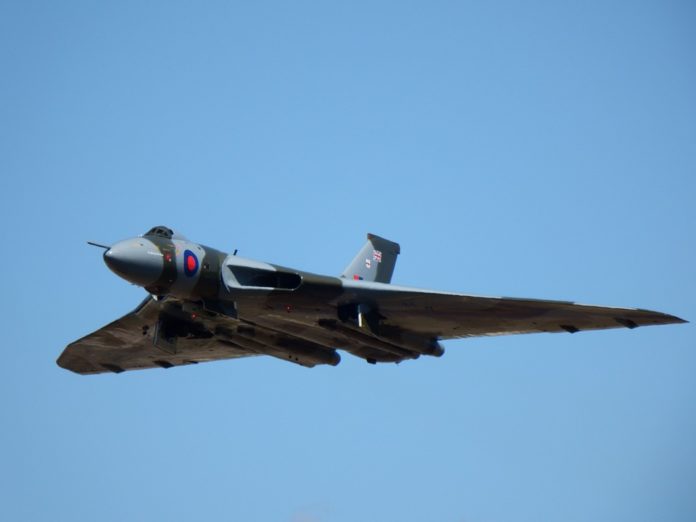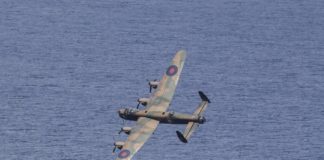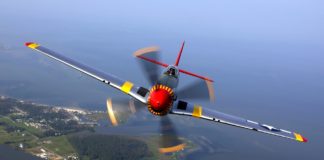Having discarded the two-seat side-by-side crewforthree in-line, the cockpit area was made much slimmer.This meant the instrument panels for all three positions were revised and while the main instruments and dials were in a panel in front of the crewman, many of the other dials, switches and controls were sited on panels on eithersideof the cockpit. Automatic voice messages and warnings were utilised forthefirsttime and were audible through the crew’s helmet. This pre-recorded system had been pioneered by Northrop Aviation’s Nortronics Division who selected Joan Elms to record the various voice commands and warnings. Elms was a well-known actress and singer of the day. In time the USAF airmen flying the B-58 would affectionately dub the voice ‘Sexy Sally.’
To enable the bomber to operate at maximum efficiency, Sperry had developed a new bombing and navigation system. The AN/ASQ-42 combined an advanced inertial navigation system with the KS-39 astro-tracker to provide heading reference; the AN/APN-113 Doppler radar was designed to provide ground velocity and windspeed data, a search radar to provide range data for bomb release and trajectory, and a radio altimeter. Sperry’s AN/ASQ-42V was estimated to be ten times more accurate than any previous bombing/ navigation system. This would be developed through the life of the B-58 and go on to be fitted to other US combat aircraft in various forms. Because the B-58 was to fly at Mach Two, SAC and others considered that there was no real need for comprehensive defensive armament and only a single 20mm T-171 E-3 Vulcan rotary cannon, with 1,200 rounds of ammunition, was sanctioned. This was fitted in the extreme tail and was controlled by the defensive systems operator (DSO) through an Emerson MD-7 fire control radar system.
As the aircraft was ordered into production there was no XB-58, usually given to the first test aircraft, with the prototype being unofficially identified as an ‘XB-58’. Although in USAF parlance prototype aircraft have an ‘X’ prefix (the B-58 would have been XB-58-CF), and though the B-58 was referred to as such within the Company and SAC, it was never officially given the’X’prefix. Recently written USAF documents, however, when referring to the two prototype B-58s, in retrospect, give the ‘X’ prefix. Work went on at Fort Worth with the first aircraft (55-0660) and in July 1956 the public first heard of the aircraft which was now named ‘Hustler’. Robert Widmer and SAC have both laid claim to giving the B-58 its name. Whoever chose the name did well in calling the Mach 2 bomber Hustler.
Delayed maiden flight
A month later the aircraft was complete and ready for engine runs, taxi trials and systems checks. For a complex aircraft there were some problems and the B-58 was not cleared for flight until the end of October. The Hustler was taken back into the flight hangar and prepared for its maiden flight, which took place in the hands of Convair test pilot Beryl Erickson on November 11, 1956, from Convair’s test facility based at Carswell AFB. This aircraft, powered by four General Electric J79-CE-1 engines, flew without the external pod and the first flight went off without incident. Given the more complex natu re of the aircraft a test programme that was different from the usual USAF requirements had been devised. All early flights were at subsonic speeds and kept below Mach One but on December 30, the ai rcraft was f I own at speed s up to Mach 1.7. While the performance of the B-58 was in no doubt, with speed and altitude achievements regarded highly, there were other problems that slowed the programme down. Fuel systems malfunctioned, especially when the aircraft accelerated or decelerated, and excessive vibration was noted. Some cracks were observed due to the vibration and brake problems caused tyre failures in a number of d ifferent situations. Pilot and crew controls were fairly standard for the day but some of the electronics in the cockpits were new and had not been fully trialled before fitting and these caused a few problems. Also, there were special maintenance issues with the nose landing gear, which retracted in a complicated fashion to avoid the centre payload. As the Hustler stood quite tall to accommodate the pod the nosewheel oleo had a pivot point, just about in-line where the tip of the pod would be when fitted, and as the nose gear retracted, the upper part of the leg moved aft causing the lower leg with the wheels on it to pivot forward. It was complicated but the arrangement allowed the entire assembly to collapse and fit snugly under the cockpit.
Test flights also revealed that the thirsty General Electric engines only returned a range of some 1,500 miles without refuelling and only 3,800 miles with refuelling; less than half the range of a B-52. Within a few months two further B-58s (55-0661 and 55-0662) had joined the programme and the real potential of the Hustler was soon established. Although much smaller than the Boeing B-52, which had first flown in April 1952 and entered USAF service in June 1955, the Hustler was faster and could deliver the required nuclear weapon on target much quicker than the Stratofortress. However, as the test programme continued it became apparent that the Hustler was far more complicated and would require a dedicated and specifically trained ground crew to maintain it. Costs were increasing and some of the problems noted above caused the test programme to slip. A review of the situation was carried out and the future of the Hustler looked in doubt once again, there were those who were in favour of cancelling the programme, but given the amount of money already spent on the aircraft it was decided to carry on. Testing continued through 1958, while the review was underway, but with many of the problems encountered being solved, the Hustler looked like being the aircraft that SAC had wanted all along. Unfortunately, between December 1958 and November 1959, seven aircraft were lost in accidents. The first in December 1958, when an electrical malfunction rendered the autotrim and radio changer inoperative. Though the three crew members ejected, pilot Major Richard Smith was killed.
On June 11, 1959, the USAF had already placed an order for 290 B-58s to include the 30 pre-production and test aircraft. The crash of the fifth YB-58 (55-0664) that year, killing the two Convair including an ambitious scheme to re-engine the B-47 to increase speed and payload; this came to nothing but was interesting at the time. On the table were the B-58 and its lengthy test programme which by the end of 1959 looked like continuing and making the aircraft obsolete before it reached service.
After 256 sorties and 1,216 hours, Category II testing was completed on June 30, 1960; Convair and the USAF prepared to commence with the third phase of testing to begin in August that year. Trials aircraft were modified and some structural alterations were carried out, while the line at Fort Worth progressed with production for the USAF, which was intending to equip five tactical wings with the first being operational by November 1960; a date that was now looking increasingly unlikely. A further blow to the programme came, not long after the production order had been placed, when SAC was informed by the Pentagon that there had to be cuts in their budget if they were to remain a viable force. Commander of SAC, General Thomas Power, had no choice but to look towards the B-58 for a solution. He cut the initial order from 290 to 148 aircraft, with the first 118, including eight TB-58 pilot trainers, to be delivered by the end of 1961. Later, it was estimated that the first 116 aircraft cost around $3 billion to produce. This figure takes in design and test work as well as production costs; it was, nevertheless, an expensive exercise.
Fuselage
It is worth considering the fuselage of the B-58, as it was quite different from any bomber then in service with the USAF. When one looks at the B-52 alongside a B-58, one could be forgiven for mistaking the Convair for a fighter; it looks so small in comparison. With a wingspan of just under 57ft (185ft for the B-52) and an overall length of nearly 97ft (B-52 at 156ft), the B-58 is a small aircraft, and that is where its strength lay. Since one of the primary requirements for the project was maximum speed, the aircraft was relatively small – 20ft longer than a B-17 with half the wing span. In fact, the B-58 was classified by the USAF as a medium bomber. Unlike the larger B-36 and B-52, the crew could not move about the aircraft once it was airborne. Each cockpit was a separate compartment and each was entered via its own opening in the upper forward fuselage. Only the pilot had a good view forwards and sideways through the large six-piece windscreen, the other two crew had a small window on either side of the cockpit. The captain had a fairly standard cockpit with the usual instruments that he would be familiar with, apart from the elevon position indicator. As the Hustler was a true delta-wing aircraft this was important and made the pilot aware of the positions of the combined ailerons and elevators. A gross weight computer provided roll and pitch corrections during flight, also an autopilot was installed which could over-rule pilot commands that might place the aircraft in danger.
This was all before solid-state and fly-by-wire and resulted in quite complex (and weighty) systems being developed for the B-58. Not so complicated was the communications between the three crew; they had the usual radio link but, as one former B-58 pilot explained, “We were separated by the arrangement of the cockpits. In between was a mass of equipment so we could not see each other. There was a line, like a domestic clothesline, which extended along one side of the cockpits. We would clip a written message to it and it was hauled back or forwards to the crew members. This was especially used when we maintained radio silence during patrols or on exercise. It was not a factory fit, I think someone on base thought it out and it was fitted to the aircraft by the ground crew. Primitive for a nuclear bomber but it worked.
Behind the captain sat the bombardier/navigator whose primary task was to work with the 1,200lb navigation and bombing system, a really heavy vacuum tube contraption which divided the front and middle cockpits. During trials the system did have teething problems but these were largely overcome by the time the aircraft was in service and could direct a B-58 to the correct location and then accomplish the launching and guiding of the chosen weapon to the target. Behind him sat the DSO who worked closely with the captain. The DSO helped with the checklists, oversaw fuel use and monitored the aircraft’s centre-of-gravity as the fuel was burned, first from the external pod-tank and then on the internal tanks. He also was responsible for the ECM systems and the defensive six-barrel 20mm Vulcan cannon. Potential targets were viewed on a scope and the gun would be brought to bear remotely on the target. The Gun Control Unit, Ammunition Box, Fire Control Tracking System, Fire Control Computer and the Gun Feeder Assembly were all located in the extreme tail under the stabiliser. The cannon was housed in a moveable unit which allowed the DSO to follow a target and let loose the 20mm shells. Even though the ammunition box held 1,200 rounds the DSO was limited to two-second bursts, mainly as there was only enough ammunition for 12 seconds and more importantly any longer and the heat generated would warp the gun barrels. There was also the danger that a round could get jammed if the barrels warped. Spent ammunition cases exited the fuselage just below the gun position.
Receiver-Transmitter, Directional Computer, Air Data Computer, Radio Altimeter Unit, Search Radar Photo Recorder, Navigation System, UHF Command Radio, Air-to-Ground IFF Unit, Bomb Damage Evaluation Data Unit, Batteries and Power Supply. Chaff dispensers were located internally beside each of the main wheel wells.
Fuel Tanks
The fuel tanks were installed in the fuselage extending into the wing: the front tank held 3,200 US Gallons (20,000lbs), the middle tank which extended almost to the leading edge of the delta-wing held 5,900 US Gallons (38,000lbs), the third tank, referred to as a ‘balance tank’ carried 1,200 US Gallons (8,000lbs) and was used to maintain the Hustler’s centre-of-gravity. A small reserve tank of 610 US Gallons (4,000lbs) was located in the fuselage between the forward and middle tanks. Convair had developed a new method to ensure that the wing tanks were fuel-tight; all interiors of the tanks were smeared with a sealant and joints made with Scotchweld, a thermosetting adhesive applied in sheet form. Each fuel tan k was then baked at 160°C to bond the Scotchweld, after which the access panels in the bottom skin were locked in place and the entire assembly pressure tested to 0.5 atmospheres. This method was tried and tested in the Convair F-102, where the whole of each wing box was a fuel tan k, and found to be extremely fuel-tight. Adapted for the B-58 on a larger scale, the system proved effective.
Additional fuel of around 8,000 US Gallons was carried in the one or two external pods. The external pods, which had started life on the drawing board as an integral part of the fuselage of the aircraft, had evolved into substantial aerodynamic units that formed part of the overall aircraft. These were the days of the Cold War and the pods were for nuclear or conventional weapons. As we have noted, they could accommodate ordnance and/or fuel.
The streamlined MB-1C pod which contained a single 10,000lb Mk 39 nuclear weapon along with fuel tanks was extensively trialled but continued fuel leaks led to several modifications. This led to the more usual two component Blu-2b unit; the upper section carried two fuel cells separated by a ‘Munitions Bay’. This could be an Mk 53 nuclear device or conventional iron bombs with high explosive or napalm. The latter was not trialled with the B-58.
In addition to the detachable mission pod, four Mk 43 bombs could be carried externally. Later the B-58 was cleared to carry the ADM-20A Quai l diversionary missile on external hardpoints.
The lower component was mainly a tank with some 4,000 US Gallons of fuel, which was used first so that it could be jettisoned leaving the weapons pod ready for release. Once the target had been selected the upper unit, which had its own retractable fins which deployed on release, was dropped. In an emergency, the lower component could be jettisoned without any interference being suffered by the upper weapons pod. Another interesting weapon, the WS-199C High Virgo Air-Launched-Ballistic- Missile, was designed for the B-58 and four test launches of the High Virgo were carried out by a B-58 to determine ballistic missile and anti-satellite system capability.




